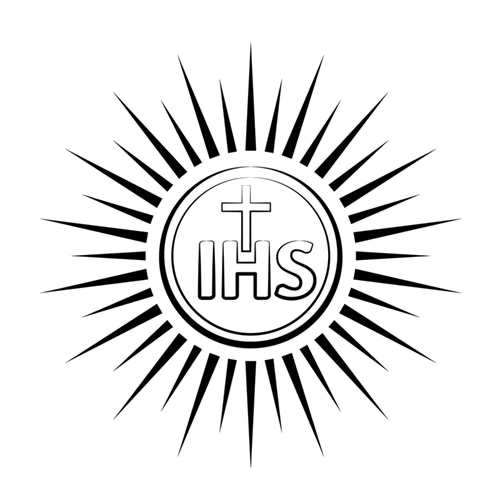The IHS Monogram is a Greek abbreviation of the name of Jesus Christ. It appeared for the first time in the third century and consists of the first three letters of IHΣΟΥΣ, which are often transliterated into IHC or IHS. The abbreviation became so widespread that it appeared on the coins of Emperor Justinian II (669-711 AD).
During the ensuing centuries, the IHS Monogram started appearing as a symbol in addition to an abbreviation. It gained popularity in the fifteenth century when Saint Bernardino of Siena advocated it as a symbol of peace. In 1541, St. Ignatius Loyola adopted an extended version, this one surrounded by the sun and decorated by three nails, as the seal of the Jesuit order.
Some sources argue that this symbol actually originated with Emperor Constantine, who had a now-famous vision of a cross with the inscription In Hoc Signo Vinces (“In this sign, you shall conquer”), or IHS for short. Others claim that it is really a derivative of a pagan symbol dedicated to the Egyptian sun gods. Given the fact that the IHS Monogram decorates the Catacomb of Priscilla, which was used for Christian burials, it seems clear that it is Christian in origin.

» Amulet
» Ajna
» Arsenic
» Merkaba
» Hung
» Yin Yang
» bindi
» IK Onkar
» Khanda
» Halo
» jiahu
» Tau
» Uraeus
» Menorah
» Quincunx
» Tilaka
» Taijitu
» Vajra
» Chai
» Chi Rho
» Bagua
» Dragon
» Hunab Ku
» Caduceus
» Infinity
» Ichthus
» Hedjet
» Lauburu
» Om
» Ankh
» Chalice
» Pentacle
» Maat
» Ogham
» Mandala
» Kartika
» Khamsa
» Heart
» Labrys
» Sun Face
» Raven
» Triskele
» Scarab
» Dove
» Hanukia
» Anubis
» Trishula
» Durga
» Mezuzah
» Bay Tree
» Geruda
» Kinnara
» Quito
» Condor
» Blue Jay
» Falcon
» Makara
» Rosary
» Uluru
» Apsaras
» Hanuman
» Serpent
» Minotaur
» Mercury
» Apex
» Vestra
» Yoni
» Astarte
» dakini
» Calabash
» Mandrake
» Rebis
» Typhon
» Vegvísir


